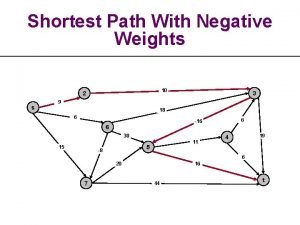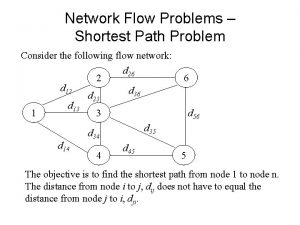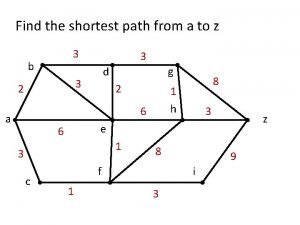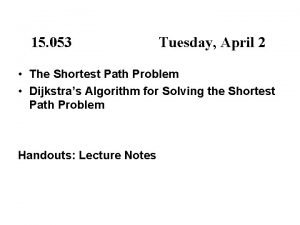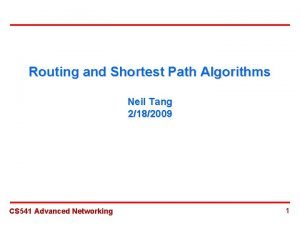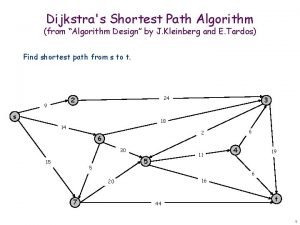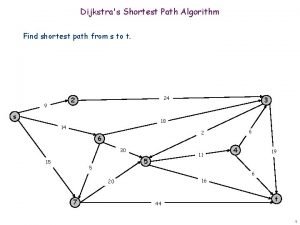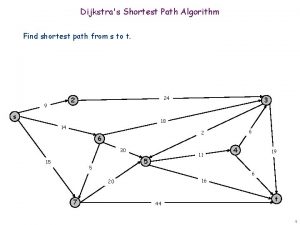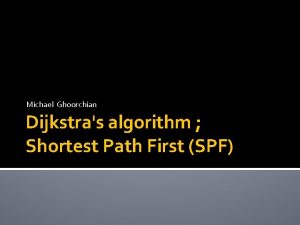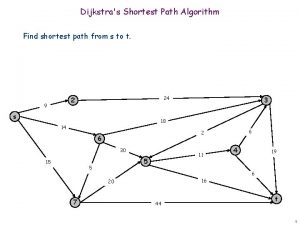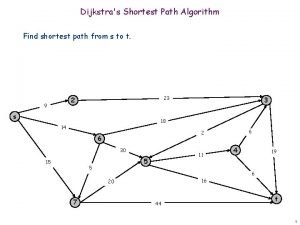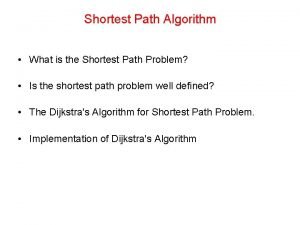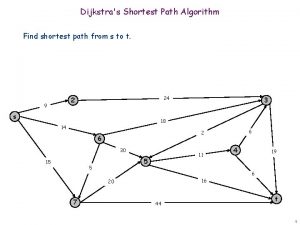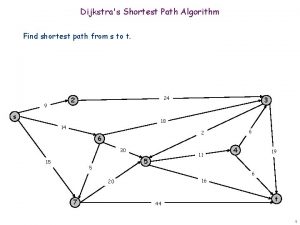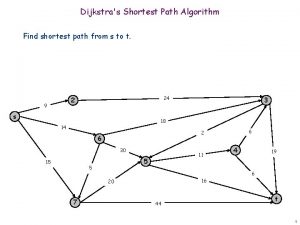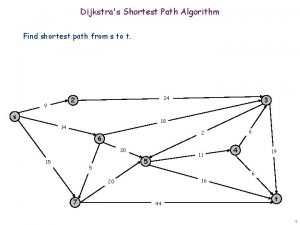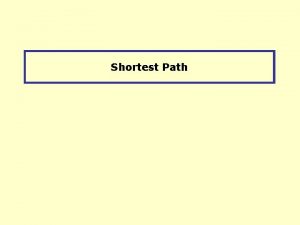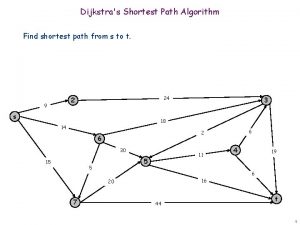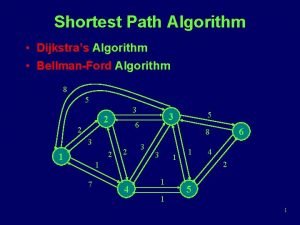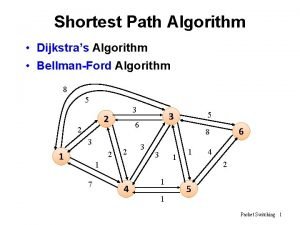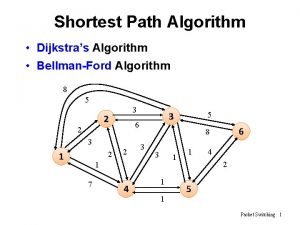1 SHORTEST PATH ALGORITHM Type shortest path into






![The algorithm S F Far off S= { }; F= { v }; d[v]= The algorithm S F Far off S= { }; F= { v }; d[v]=](https://slidetodoc.com/presentation_image_h2/7ba74deadc674df0618988d93ea79818/image-7.jpg)
![The algorithm S F Far off S= { }; F= { v }; d[v]= The algorithm S F Far off S= { }; F= { v }; d[v]=](https://slidetodoc.com/presentation_image_h2/7ba74deadc674df0618988d93ea79818/image-8.jpg)

![The algorithm S F w Far off f w 1. For s, d[s] is The algorithm S F w Far off f w 1. For s, d[s] is](https://slidetodoc.com/presentation_image_h2/7ba74deadc674df0618988d93ea79818/image-10.jpg)
![The algorithm S f F w w Far off w 1. For s, d[s] The algorithm S f F w w Far off w 1. For s, d[s]](https://slidetodoc.com/presentation_image_h2/7ba74deadc674df0618988d93ea79818/image-11.jpg)
![The algorithm S f F w w Far off 1. For s, d[s] is The algorithm S f F w w Far off 1. For s, d[s] is](https://slidetodoc.com/presentation_image_h2/7ba74deadc674df0618988d93ea79818/image-12.jpg)



![S F Far off Maintain backpointers S= { }; F= {v}; d[v]= 0; Wow! S F Far off Maintain backpointers S= { }; F= {v}; d[v]= 0; Wow!](https://slidetodoc.com/presentation_image_h2/7ba74deadc674df0618988d93ea79818/image-16.jpg)


![S F Far off S= { }; F= {v}; d[v]= 0; while (F ≠ S F Far off S= { }; F= {v}; d[v]= 0; while (F ≠](https://slidetodoc.com/presentation_image_h2/7ba74deadc674df0618988d93ea79818/image-19.jpg)
![S F Far off S= { }; F= {v}; d[v]= 0; while (F ≠ S F Far off S= { }; F= {v}; d[v]= 0; while (F ≠](https://slidetodoc.com/presentation_image_h2/7ba74deadc674df0618988d93ea79818/image-20.jpg)

![S F Far off S= { }; F= {v}; d[v]= 0; while (F ≠ S F Far off S= { }; F= {v}; d[v]= 0; while (F ≠](https://slidetodoc.com/presentation_image_h2/7ba74deadc674df0618988d93ea79818/image-22.jpg)










![S F Far off 1 x O(1) 1 S= { }; F= {v}; d[v]= S F Far off 1 x O(1) 1 S= { }; F= {v}; d[v]=](https://slidetodoc.com/presentation_image_h2/7ba74deadc674df0618988d93ea79818/image-33.jpg)
- Slides: 33

1 SHORTEST PATH ALGORITHM Type shortest path into the Java. Hyper. Text Filter Field Lecture 20 CS 2110. Spring 2019

A 6. Implement shortest-path algorithm 2 One semester: mean time: 4. 2 hrs, median time: 4. 5 hrs. max: 30 hours !!!! We give you complete set of test cases and a GUI to play with. Don’t wait until the last minute. It’s easy to make a mistake, and you may not be able to get help to find it. Efficiency and simplicity of code will be graded. Read handout carefully: 2. Important! Grading guidelines. We demo it.

Dijkstra’s shortest path algorithm The n (> 0) nodes of a graph numbered 0. . n-1. Each edge has a positive weight. wgt(v 1, v 2) is the weight of the edge from node v 1 to v 2. Some node v be selected as the start node. Calculate length of shortest path from v to each node. Use an array d[0. . n-1]: for each node w, store in d[w] the length of the shortest path from v to w. v 2 4 0 3 1 4 4 2 1 3 3 3 d[0] = 2 d[1] = 5 d[2] = 6 d[3] = 7 d[4] = 0

Settled S Frontier F Far off The loop invariant (edges leaving the Far off set and edges from the Frontier to the Settled set are not shown) f 1. For a Settled node s, a shortest path from v to s contains only settled nodes and d[s] is length of shortest v s path. 2. For a Frontier node f, at least one v f path contains only settled nodes (except perhaps for f) and d[f] is the length of the shortest such path v f 3. All edges leaving S go to F. Settled S This edge does not leave S! Another way of saying 3: There are no edges from S to the far-off set. 4

Settled S Frontier F g f Far off Theorem about the invariant v f L[g] ≥ L[f] g 1. For a Settled node s, d[s] is length of shortest v s path. 2. For a Frontier node f, d[f] is length of shortest v f path using only Settled nodes (except for f). 3. All edges leaving S go to F. Theorem. For a node f in F with minimum d value (over nodes in F), d[f] is the length of a shortest path from v to f. Case 1: v is in S. Case 2: v is in F. Note that d[v] is 0; it has minimum d value 5

Settled S Frontier F f Far off Theorem. For a node f in F with minimum d value (over nodes in F), d[f] is the length of a shortest path from v to f. What does theorem tell us about this frontier set? (Cortland, 20 miles) (Dryden, 11 miles) (Enfield, 10 miles) (Tburg, 15 miles) Answer: The shortest path from the start node to Enfield has length 10 miles. Note: the following answer is incorrect because we haven’t said a word about the algorithm! We are just investigating properties of the invariant: Enfield can be moved to the settled set. 6
![The algorithm S F Far off S F v dv The algorithm S F Far off S= { }; F= { v }; d[v]=](https://slidetodoc.com/presentation_image_h2/7ba74deadc674df0618988d93ea79818/image-7.jpg)
The algorithm S F Far off S= { }; F= { v }; d[v]= 0; v 1. For s, d[s] is length of shortest v s path. 2. For f, d[f] is length of shortest v f path using red nodes (except for f). 3. Edges leaving S go to F. Theorem: For a node f in F with min d value, d[f] is shortest path length Loopy question 1: How does the loop start? What is done to truthify the invariant? 7
![The algorithm S F Far off S F v dv The algorithm S F Far off S= { }; F= { v }; d[v]=](https://slidetodoc.com/presentation_image_h2/7ba74deadc674df0618988d93ea79818/image-8.jpg)
The algorithm S F Far off S= { }; F= { v }; d[v]= 0; while ( F ≠ {} ) { 1. For s, d[s] is length of shortest v s path. 2. For f, d[f] is length of shortest v f path using red nodes (except for f). 3. Edges leaving S go to F. Theorem: For a node f in F with min d value, d[f] is shortest path length } Loopy question 2: When does loop stop? When is array d completely calculated? 8

The algorithm S F f f Far off S= { }; F= { v }; d[v]= 0; while ( F ≠ {} ) { f= node in F with min d value; Remove f from F, add it to S; 1. For s, d[s] is length of shortest v s path. 2. For f, d[f] is length of shortest v f path using red nodes (except for f). 3. Edges leaving S go to F. } Theorem: For a node f in F with min d value, d[f] is shortest path length Loopy question 3: Progress toward termination? 9
![The algorithm S F w Far off f w 1 For s ds is The algorithm S F w Far off f w 1. For s, d[s] is](https://slidetodoc.com/presentation_image_h2/7ba74deadc674df0618988d93ea79818/image-10.jpg)
The algorithm S F w Far off f w 1. For s, d[s] is length of shortest v s path. 2. For f, d[f] is length of shortest v f path using red nodes (except for f). S= { }; F= { v }; d[v]= 0; while ( F ≠ {} ) { f= node in F with min d value; Remove f from F, add it to S; for each neighbor w of f { if (w not in S or F) { } else { 3. Edges leaving S go to F. } Theorem: For a node f in F } with min d value, d[f] is } shortest path length Loopy question 4: Maintain invariant? 10
![The algorithm S f F w w Far off w 1 For s ds The algorithm S f F w w Far off w 1. For s, d[s]](https://slidetodoc.com/presentation_image_h2/7ba74deadc674df0618988d93ea79818/image-11.jpg)
The algorithm S f F w w Far off w 1. For s, d[s] is length of shortest v s path. 2. For f, d[f] is length of shortest v f path using red nodes (except for f). 3. Edges leaving S go to F. S= { }; F= { v }; d[v]= 0; while ( F ≠ {} ) { f= node in F with min d value; Remove f from F, add it to S; for each neighbor w of f { if (w not in S or F) { d[w]= d[f] + wgt(f, w); add w to F; } else { } Theorem: For a node f in F } with min d value, d[f] is } shortest path length Loopy question 4: Maintain invariant? 11
![The algorithm S f F w w Far off 1 For s ds is The algorithm S f F w w Far off 1. For s, d[s] is](https://slidetodoc.com/presentation_image_h2/7ba74deadc674df0618988d93ea79818/image-12.jpg)
The algorithm S f F w w Far off 1. For s, d[s] is length of shortest v s path. 2. For f, d[f] is length of shortest v f path of form f 3. Edges leaving S go to F. Theorem: For a node f in F with min d value, d[f] is its shortest path length S= { }; F= { v }; d[v]= 0; while ( F ≠ {} ) { f= node in F with min d value; Remove f from F, add it to S; for each neighbor w of f { if (w not in S or F) { d[w]= d[f] + wgt(f, w); add w to F; } else if (d[f] + wgt (f, w) < d[w]) { d[w]= d[f] + wgt(f, w); } } } Algorithm is finished! 12

Extend algorithm to include the shortest path Let’s extend the algorithm to calculate not only the length of the shortest path but the path itself. 0 1 3 4 2 v 4 4 d[0] = 2 d[1] = 5 d[2] = 6 d[3] = 7 d[4] = 0 3 2 1 3 13

Extend algorithm to include the shortest path Question: should we store in v itself the shortest path from v to every node? Or do we need another data structure to record these paths? Not finished! v 0 And how do 1 0 we maintain it? 0 2 0 1 3 4 2 v 4 4 d[0] = 2 d[1] = 5 d[2] = 6 d[3] = 7 d[4] = 0 3 2 1 3 14

Extend algorithm to include the shortest path For each node, maintain the backpointer on the shortest path to that node. Shortest path to 0 is v -> 0. Node 0 backpointer is 4. Shortest path to 1 is v -> 0 -> 1. Node 1 backpointer is 0. 0 2 v 4 1 3 4 4 3 2 1 3 bk[w] is w’s backpointer bk[0] = 4 d[0] = 2 bk[1] = 0 d[1] = 5 d[2] = 6 d[3] = 7 bk[4] (none) d[4] = 0 15
![S F Far off Maintain backpointers S F v dv 0 Wow S F Far off Maintain backpointers S= { }; F= {v}; d[v]= 0; Wow!](https://slidetodoc.com/presentation_image_h2/7ba74deadc674df0618988d93ea79818/image-16.jpg)
S F Far off Maintain backpointers S= { }; F= {v}; d[v]= 0; Wow! It’s so easy to while (F ≠ {}) { maintain backpointers! f= node in F with min d value; Remove f from F, add it to S; When w not in S or F: for each neighbor w of f { Getting first shortest path so if (w not in S or F) { far: d[w]= d[f] + wgt(f, w); f v w add w to F; bk[w]= f; } else if (d[f] + wgt (f, w) < d[w]) { When w in S or F and have shorter path to d[w]= d[f] + wgt(f, w); w: bk[w]= f; } }} f v w 16

S F Far off This is our final high-level algorithm. These issues and S= { }; F= {v}; d[v]= 0; questions remain: while (F ≠ {}) { 1. How do we implement F? f= node in F with min d value; 2. The nodes of the graph Remove f from F, add it to S; will be objects of class Node, not ints. How will for each neighbor w of f { we maintain the info in if (w not in S or F) { arrays d and bk? d[w]= d[f] + wgt(f, w); 3. How do we tell quickly add w to F; bk[w]= f; whether w is in S or F? } else if (d[f]+wgt (f, w) < d[w]) { 4. How do we analyze d[w]= d[f] + wgt(f, w); execution time of the bk[w]= f; algorithm? } }} 17

S F Far off 1. How do we implement F? S= { }; F= {v}; d[v]= 0; while (F ≠ {}) { f= node in F with min d value; Remove f from F, add it to S; for each neighbor w of f { if (w not in S or F) { d[w]= d[f] + wgt(f, w); add w to F; bk[w]= f; } else if (d[f]+wgt (f, w) < d[w]) { d[w]= d[f] + wgt(f, w); bk[w]= f; } }} Use a min-heap, with the priorities being the distances! Distances ---priorities--- will change. That’s why we need change. Priority in Heap. java 18
![S F Far off S F v dv 0 while F S F Far off S= { }; F= {v}; d[v]= 0; while (F ≠](https://slidetodoc.com/presentation_image_h2/7ba74deadc674df0618988d93ea79818/image-19.jpg)
S F Far off S= { }; F= {v}; d[v]= 0; while (F ≠ {}) { f= node in F with min d value; Remove f from F, add it to S; for each neighbor w of f { if (w not in S or F) { d[w]= d[f] + wgt(f, w); add w to F; bk[w]= f; } else if (d[f]+wgt (f, w) < d[w]) { d[w]= d[f] + wgt(f, w); bk[w]= f; } }} For what nodes do we need a distance and a backpointer? 19
![S F Far off S F v dv 0 while F S F Far off S= { }; F= {v}; d[v]= 0; while (F ≠](https://slidetodoc.com/presentation_image_h2/7ba74deadc674df0618988d93ea79818/image-20.jpg)
S F Far off S= { }; F= {v}; d[v]= 0; while (F ≠ {}) { f= node in F with min d value; Remove f from F, add it to S; for each neighbor w of f { if (w not in S or F) { d[w]= d[f] + wgt(f, w); add w to F; bk[w]= f; } else if (d[f]+wgt (f, w) < d[w]) { d[w]= d[f] + wgt(f, w); bk[w]= f; } }} For what nodes do we need a distance and a backpointer? Instead of arrays d and b, keep information associated with a node. Use what data structure for the two values? 20

S F Far off For what nodes do we need a distance and a backpointer? S= { }; F= {v}; d[v]= 0; while (F ≠ {}) { f= node in F with min d value; Remove f from F, add it to S; for each neighbor w of f { if (w not in S or F) { d[w]= d[f] + wgt(f, w); add w to F; bk[w]= f; } else if (d[f]+wgt (f, w) < d[w]) { d[w]= d[f] + wgt(f, w); public class DB { bk[w]= f; private int dist; private node bkptr; } … }} } 21
![S F Far off S F v dv 0 while F S F Far off S= { }; F= {v}; d[v]= 0; while (F ≠](https://slidetodoc.com/presentation_image_h2/7ba74deadc674df0618988d93ea79818/image-22.jpg)
S F Far off S= { }; F= {v}; d[v]= 0; while (F ≠ {}) { f= node in F with min d value; Remove f from F, add it to S; for each neighbor w of f { if (w not in S or F) { d[w]= d[f] + wgt(f, w); add w to F; bk[w]= f; } else if (d[f]+wgt (f, w) < d[w]) { d[w]= d[f] + wgt(f, w); bk[w]= f; } }} F implemented as a heap of Nodes. What data structure to use to maintain a DB object for each node in S and F? For every node in S or F we need both its d-value and its backpointer (null for v): public class DB { private int dist; private node bkptr; … } 22

S F Far off Given a node in S or F, we need to gets its DB object quickly. What data structure to use? S= { }; F= {v}; d[v]= 0; while (F ≠ {}) { f= node in F with min d value; Remove f from F, add it to S; Hash. Map<Node, DB > info for each neighbor w of f { Implement this algorithm. if (w not in S or F) { F: implemented as a min-heap. d[w]= d[f] + wgt(f, w); info: replaces S, d, b add w to F; bk[w]= f; } else if (d[f]+wgt (f, w) < d[w]) { public class DB { d[w]= d[f] + wgt(f, w); private int dist; bk[w]= f; private node bkptr; } … }} Final abstract algorithm } 23

S F Far off Investigate execution time. Important: understand algorithm well enough to easily determine the total number of times each part is executed/evaluated S= { }; F= {v}; d[v]= 0; while (F ≠ {}) { f= node in F with min d value; Remove f from F, add it to S; for each neighbor w of f { Assume: if (w not in S or F) { n nodes reachable from v d[w]= d[f] + wgt(f, w); e edges leaving those n nodes add w to F; bk[w]= f; } else if (d[f]+wgt (f, w) < d[w]) { d[w]= d[f] + wgt(f, w); public class DB { bk[w]= f; private int dist; } private node bkptr; }} Hash. Map<Node, DB> info … } 24

S F Far off Assume: 1 x n nodes reachable from v S= { }; F= {v}; d[v]= 0; e edges leaving the n nodes true n x while (F ≠ {}) { f= node in F with min d value; n x Question. How many times n x does F ≠ {} evaluate to Remove f from F, add it to S; for each neighbor w of f { true? if (w not in S or F) { To false? d[w]= d[f] + wgt(f, w); add w to F; bk[w]= f; } else if (d[f]+wgt (f, w) < d[w]) { d[w]= d[f] + wgt(f, w); public class DB { bk[w]= f; private int dist; } private node bkptr; }} Hash. Map<Node, DB> info … } 25

Directed graph n nodes reachable from v 1 x e edges leaving the n nodes S= { }; F= {v}; d[v]= 0; true n x while (F ≠ {}) { f= node in F with min d value; n x Harder: In total, how many Remove f from F, add it to S; times does the loop for each neighbor w of f { if (w not in S or F) { for each neighbor w of f d[w]= d[f] + wgt(f, w); find a neighbor and execute add w to F; bk[w]= f; the repetend? } else if (d[f]+wgt (f, w) < d[w]) { d[w]= d[f] + wgt(f, w); public class DB { bk[w]= f; private int dist; } private node bkptr; }} Hash. Map<Node, DB> info … S F Far off } 26

S F Far off Directed graph n nodes reachable from v 1 x e edges leaving the n nodes S= { }; F= {v}; d[v]= 0; true n x while (F ≠ {}) { f= node in F with min d value; n x Harder: In total, how many Remove f from F, add it to S; times does the loop for each neighbor w of f { if (w not in S or F) { for each neighbor w of f d[w]= d[f] + wgt(f, w); find a neighbor and execute add w to F; bk[w]= f; the repetend? } else if (d[f]+wgt (f, w) < d[w]) { Answer: The for-each d[w]= d[f] + wgt(f, w); statement is executed ONCE for each node. bk[w]= f; During that execution, the repetend is executed } once for each neighbor. In total then, the }} repetend is executed once for each neighbor of each node. A total of e times. 27

S F Far off Directed graph n nodes reachable from v 1 x e edges leaving the n nodes S= { }; F= {v}; d[v]= 0; true n x while (F ≠ {}) { f= node in F with min d value; n x nx Remove f from F, add it to S; for each neighbor w of f { true e x How many times does if (w not in S or F) { w not in S or F d[w]= d[f] + wgt(f, w); n-1 x evaluate to true? add w to F; bk[w]= f; n-1 x } else if (d[f]+wgt (f, w) < d[w]) { d[w]= d[f] + wgt(f, w); bk[w]= f; } }} 28

S F Far off Directed graph n nodes reachable from v 1 x e edges leaving the n nodes S= { }; F= {v}; d[v]= 0; true n x while (F ≠ {}) { f= node in F with min d value; n x nx Remove f from F, add it to S; for each neighbor w of f { true e x if (w not in S or F) { d[w]= d[f] + wgt(f, w); n-1 x add w to F; bk[w]= f; n-1 x How many times is the } else if (d[f]+wgt (f, w) < d[w]) { if-statement executed? d[w]= d[f] + wgt(f, w); bk[w]= f; Answer: The repetend is executed e times. The } if-condition in the repetend is true n-1 times. So the else-part is executed e-(n-1) times. Answer: }} e+1 -n times. 29

S F Far off Directed graph n nodes reachable from v 1 x e edges leaving the n nodes S= { }; F= {v}; d[v]= 0; true n x while (F ≠ {}) { f= node in F with min d value; n x nx Remove f from F, add it to S; for each neighbor w of f { true e x ex if (w not in S or F) { d[w]= d[f] + wgt(f, w); n-1 x add w to F; bk[w]= f; n-1 x } else if (d[f]+wgt (f, w) < d[w]) { e+1 -n x d[w]= d[f] + wgt(f, w); How many times is the ifcondition true and d[w] changed? bk[w]= f; } Answer: We don’t know. Varies. }} expected case: e+1 -x times. 30

S F Far off Directed graph n nodes reachable from v 1 x e edges leaving the n nodes S= { }; F= {v}; d[v]= 0; true n x Expected-case analysis while (F ≠ {}) { f= node in F with min d value; n x We know how often each Remove f from F, add it to S; for each neighbor w of f { true e x statement is executed. e x Multiply by its O(…) time if (w not in S or F) { d[w]= d[f] + wgt(f, w); n-1 x add w to F; bk[w]= f; n-1 x } else if (d[f]+wgt (f, w) < d[w]) { e+1 -n x d[w]= d[f] + wgt(f, w); e+1 -n x bk[w]= f; } }} 31

S F Far off Directed graph n nodes reach 1 x O(1) S= { }; F= {v}; d[v]= 0; able from v true n x O(n) while (F ≠ {}) { e edges leaving f= node in F with min d value; n x O(n) the n nodes n x O(n log n) Expected-case Remove f from F, add it to S; for each neighbor w of f { true e x O(e) analysis e x O(e) if (w not in S or F) { d[w]= d[f] + wgt(f, w); n-1 x O(n) add w to F; bk[w]= f; n-1 x O(n log n) } else if (d[f]+wgt (f, w) < d[w]) { e+1 -n x O(e–n) d[w]= d[f] + wgt(f, w); e+1 -n x O((e–n) log n) e+1 -n x O(e–n) bk[w]= f; } We know how often each statement is }} executed. Multiply by its O(…) time 32
![S F Far off 1 x O1 1 S F v dv S F Far off 1 x O(1) 1 S= { }; F= {v}; d[v]=](https://slidetodoc.com/presentation_image_h2/7ba74deadc674df0618988d93ea79818/image-33.jpg)
S F Far off 1 x O(1) 1 S= { }; F= {v}; d[v]= 0; 2 true n x O(n) while (F ≠ {}) { 3 f= node in F with min d value; n x O(n) 4 n x O(n log n) Remove f from F, add it to S; for each neighbor w of f { true e x O(e) 5 e x O(e) if (w not in S or F) { 6 d[w]= d[f] + wgt(f, w); n-1 x O(n) 7 8 add w to F; bk[w]= f; n-1 x O(n log n) } else if (d[f]+wgt (f, w) < d[w]) { e+1 -n x O(e–n) 9 10 d[w]= d[f] + wgt(f, w); e+1 -n x O((e–n) log n). 10 e+1 -n x O(e–n) bk[w]= f; } Dense graph, so e close to n*n: Line 10 gives O(n 2 log n) }} Sparse graph, so e close to n: Line 4 gives O(n log n) 33
 Floyd's algorithm pseudocode
Floyd's algorithm pseudocode Does dijkstra work with negative edges
Does dijkstra work with negative edges Dijkstra algorithm in discrete mathematics
Dijkstra algorithm in discrete mathematics Shortest path algorithm python
Shortest path algorithm python Successive shortest path algorithm
Successive shortest path algorithm Augmenting path algorithm
Augmenting path algorithm Shortest path algorithm in mapreduce
Shortest path algorithm in mapreduce Single-source shortest paths
Single-source shortest paths Shortest path to get food
Shortest path to get food Shortest path linear programming
Shortest path linear programming Shortest path problem adalah
Shortest path problem adalah Tramp steamer problem
Tramp steamer problem Dijkstra algorithm graph theory
Dijkstra algorithm graph theory Shortest path from source to destination in weighted graph
Shortest path from source to destination in weighted graph Single source shortest path in c
Single source shortest path in c Shortest path problem excel
Shortest path problem excel Minimum spanning tree shortest path
Minimum spanning tree shortest path Find shortest path
Find shortest path Shortest path formulation
Shortest path formulation Shortest path
Shortest path Fme shortest path finder
Fme shortest path finder Shortest path
Shortest path Sssp
Sssp Rbs shortest path
Rbs shortest path References of climate change
References of climate change Shortest path
Shortest path Shortest path
Shortest path Dijkestra
Dijkestra Rock cycle
Rock cycle Hot path cold path
Hot path cold path Floyd warshall path reconstruction
Floyd warshall path reconstruction Edge chasing algorithm
Edge chasing algorithm Least cost algorithm
Least cost algorithm Path pushing algorithm
Path pushing algorithm











